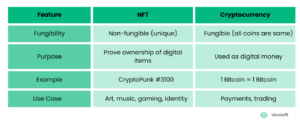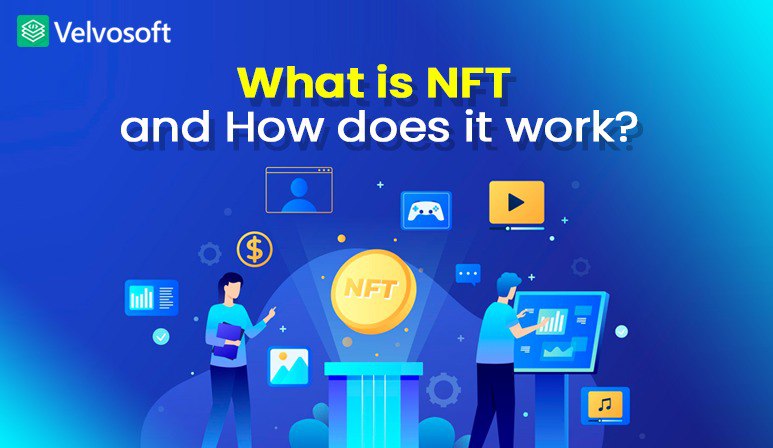Table of Contents
Remember the time when owning a meme, a song, or a piece of digital art didn’t really mean you owned it? That changed the moment NFTs means Non-Fungible Tokens which entered the scene. It is powered by blockchain, NFTs give every digital item its own unique ID. Whether it’s a music track, a digital painting, or even a plot of virtual land, that token says: this one is truly yours.
In 2024, the NFT space pulled in around $683.9 million in global revenue. While projections show a slight dip to $608.6 million in 2025, the long game looks strong. By 2029, the market is expected to explode to $247 billion, growing at nearly 42% annually. Even after the dip in 2022, landmark moments like Beeple’s “Everydays: the First 5000 Days” selling for $69 million; prove that NFTs still have cultural staying power.
So what exactly is an NFT? Think of it as a digital certificate of ownership stored on a blockchain. It proves something is authentic and owned by you. Unlike traditional cryptocurrencies where every token is the same, NFTs are one of a kind. While not every NFT is worth a fortune, the ability to prove you own that original meme, beat, or gif has captured the imagination of both artists and collectors.
What is an NFT (Non-Fungible Token)?
Short Answer:
An NFT (Non-Fungible Token) is a one-of-a-kind digital certificate stored on a blockchain that proves ownership of a unique digital item like a piece of art, music, tweet, or even a gaming skin.
In Short,
Non-Fungible: It’s unique and irreplaceable. A ₹10 note is fungible that you can swap it for another ₹10 note. But a digital artwork or a rare trading card? That’s non-fungible and there’s only one like it.
Token: A digital asset secured by blockchain technology. It verifies ownership, authenticity, and tracks the item’s history.
NFT = A one-of-a-kind digital item + Proof of ownership on a blockchain
NFT vs Cryptocurrency
Now that you understand what an NFT is, let’s clear up a common confusion. NFTs and cryptocurrencies may look similar, but they serve very different purposes. Below, we break down the key differences to help you understand how each one works and where they are used.

How Do NFTs Work?
When you buy or create an NFT, how does all of this actually work behind the scenes?
Minting (Creation): It all starts when a creator uploads a digital file an image, a video, a song and “mints” it as an NFT using a smart contract on a blockchain like Ethereum, Polygon, or Solana. This process turns the file into a unique, traceable digital asset.
Storage: Interestingly, the file itself isn’t stored on the blockchain. Instead, it lives on decentralized systems like IPFS (InterPlanetary File System). The NFT acts like a digital pointer, holding metadata that links directly to that file.
Ownership & Verification: When you own an NFT, your wallet address becomes part of the blockchain’s permanent, public record. It’s your proof of ownership like transparent, secure, and unchangeable. Anyone can verify that the NFT belongs to you.
Marketplace & Transfer: NFTs aren’t just collectibles and they’re assets – a digital asset. You can buy, sell, or trade them on platforms like OpenSea, Blur, Magic Eden, or Rarible. Once a sale is made, ownership shifts instantly to the new wallet holder.
Example
Owning an NFT is like holding a signed certificate of authenticity for a digital artwork. You don’t control the image file itself like a downloaded JPEG but you do own the verified token that says, “This is mine.”
What’s Actually Inside an NFT? (Token, File & Metadata)
A lot of people think an NFT is the image or video they see but that’s not entirely true. An NFT is more like a digital package made up of three key parts that work together to prove ownership on the blockchain:
The Token: This is the core of the NFT and it’s stored on a blockchain like Ethereum, Polygon, or Solana. It contains the ownership record and transaction history. Think of it as your digital receipt or certificate of authenticity.
The File (Art, Music, etc.): This is the actual content like a JPG, MP3, video, or 3D model. But it’s usually not stored directly on the blockchain because of storage limitations. Instead, it’s saved off-chain on decentralized systems like IPFS (InterPlanetary File System) or Arweave.
The Metadata: This is the glue that ties everything together. It includes important details like the title, creator’s name, description, and most importantly a link to the file itself.
Why this matters?
If the file is stored on a centralized server (like a regular website), and that server shuts down, the NFT could break. That’s why serious NFT projects use decentralized storage and it keeps your digital asset safe and accessible, even if one provider disappears.
What Can Be Turned Into an NFT?
Today, almost anything digital and even some real-world things can be turned into an NFT. If it’s something you can say is one of a kind, it can be made into a token.
Here are some easy examples:
Digital Art – Pictures, drawings, and even moving animations can be sold as NFTs.
Music & Songs – Musicians can sell songs straight to fans, and even earn money every time it’s used.
Tweets & Memes – Funny posts or viral moments online? Yep, people have turned those into NFTs too.
Virtual Land – In online worlds like Decentraland or The Sandbox, people buy land just like in real life.
Domain Names – Web3 names like .eth can be owned and used like digital property.
Game Items – Skins, weapons, or avatars in games that you can buy, sell, or trade for real value.
Event Tickets – Tickets for shows or events that live on the blockchain which easy to use and hard to fake.
Certificates – School diplomas or ID cards that are safe, secure, and easy to check online.
NFTs are changing what it means to “own” something online. They give creators, fans, and even big companies new ways to share and trade value.
Are NFTs Secure and Authentic?
Yes, NFTs are secure and here’s the reason why NFT are the secure:
Because NFTs are stored on blockchains like Ethereum or Polygon, they come with some built-in benefits:
Tamper-proof: Once an NFT is recorded on the blockchain, it can’t be altered or faked. That means no duplicates, no forgeries and ownership is 100% real and traceable.
Transparent: The full history of the NFT like who created it, who bought it, and when is visible to anyone. You don’t need to “trust” someone’s word becuase you can check the blockchain yourself.
Trustless System: There’s no need for a gallery, agent, or music label to prove it’s yours. The blockchain acts as your proof of ownership.
But Still be careful;
Not everything in the NFT world is safe. Scams do exist, like:
- Fake collections mimicking popular artists
- “Rug pulls” where creators disappear after launching a project
- Phishing links that steal your NFTs
Pro Tip: Always double-check the project’s smart contract, verify the creator’s wallet address, and use trusted platforms like OpenSea or Magic Eden before buying.
What Gives an NFT Value?
Great question! Not all NFTs are created equal; some sell for millions, others fade into obscurity. So, what makes one NFT valuable while another isn’t? Here’s what typically drives the value:
Scarcity: Just like rare trading cards or limited-edition sneakers, the fewer copies there are of an NFT, the more valuable it can be. Rarity often drives demand.
Utility: NFTs aren’t just pretty pictures. Many now come with real perks like VIP event access, royalties, early product drops, or even staking rewards in DeFi projects. The more useful it is, the more valuable it becomes.
Creator Reputation: If the NFT comes from a well-known artist, musician, or brand, it’s naturally more in demand. Think Beeple, Nike, or Snoop Dogg.
Community: Projects like Bored Ape Yacht Club (BAYC) exploded in value because of the strong, loyal community behind them. When a community is active and passionate, the value often grows.
Story or Meme Power: Some NFTs go viral simply because they’re hilarious, nostalgic, or culturally iconic like the famous “Doge” NFT. Meme value is real value in the digital world.
In 2025, utility-based NFTs are leading the way. Instead of just art, people want NFTs that do something like act as a membership pass, unlock features in a game, or serve as identity credentials.
Real-World Examples of NFTs
Bored Ape Yacht Club (BAYC): A collection of ape avatars that became a status symbol for celebrities.
NBA Top Shot: Tokenized NBA highlights sold as digital collectibles.
Beeple’s Artwork: Sold for $69 million as an NFT at Christie’s.
Music NFTs: Artists like Snoop Dogg, Grimes, and 3LAU sell songs directly to fans as NFTs.
Gaming: Games like Axie Infinity and Gods Unchained use NFTs for characters and items.
Future of NFTs: 2025 and Beyond
In 2025, NFTs have grown far beyond digital art. They’re now powering digital identity systems, real estate tokenization, fractional ownership of assets, and even supply chain tracking. Creators use NFTs to manage music and video rights, while DAOs rely on them for governance and voting. Thanks to Layer 2 scaling and eco-friendly blockchains, NFTs are becoming cheaper, faster, and greener to use that is unlocking real-world utility across industries. From secure credentials to decentralized ownership, the future of NFTs is practical, scalable, and just getting started.
FAQs
Can I screenshot an NFT and claim ownership?
No. A screenshot doesn’t give you blockchain ownership just like photographing art doesn’t make it yours.
Are NFTs only for rich people?
Not anymore. Many NFTs now cost under $10, especially in Web3 games and social platforms.
Can I sell my NFT?
Yes. You can list it on marketplaces like OpenSea or Magic Eden, but value depends on demand.
Do I get royalties when my NFT is resold?
If you’re the original creator, yes! many platforms support automatic royalty payouts.
Are NFTs a good investment?
Some are profitable, but many aren’t. Always do your own research before buying.
Where can I buy NFTs?
On platforms like OpenSea, Blur, or Magic Eden using a crypto wallet like MetaMask or Phantom.
What’s the safest way to store NFTs?
Use a hardware wallet like Ledger or Trezor for the best security.
Can NFTs represent real-world items?
Yes. NFTs now represent assets like real estate, tickets, and digital certificates.
Are NFTs legal?
Yes, in most countries but regulations are still evolving, especially for financial NFTs.
Final Thoughts
NFTs are no longer just a passing trend and they’re becoming the backbone of digital ownership in the Web3 era. Whether you’re a creator looking to monetize your work, a gamer earning rewards through in-game assets, or an investor exploring new opportunities, NFTs offer real control over your digital assets. They empower users to own, trade, and profit from everything from artwork and collectibles to music, virtual land, and tokenized experiences. And in 2025, we’re only beginning to unlock their full potential. From identity verification to fractional ownership and real-world applications, NFTs are reshaping how we interact with the digital world and one token at a time.
